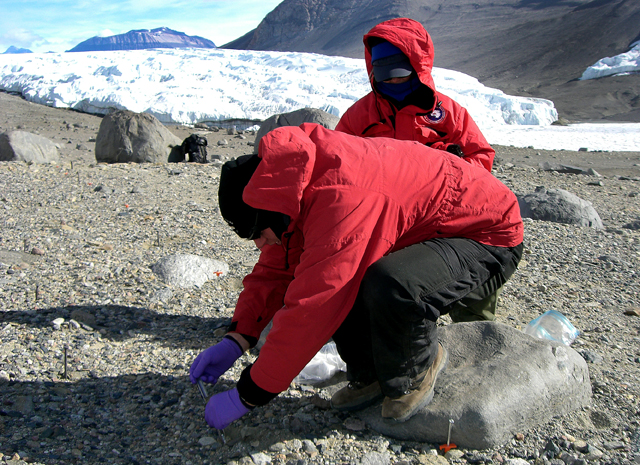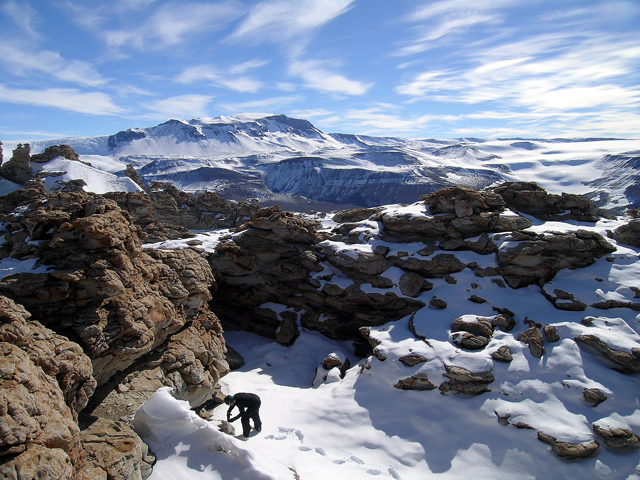Bounds of biodiversityLTER scientists to seek out life in Transantarctic MountainsPosted November 20, 2009
Scientists who normally spend much of the austral summer in the McMurdo Dry Valleys Byron Adams “We’re really interested about the biodiversity of these organisms that are there, and we’re particularly interested in their evolutionary history as well,” explained Adams, a member of the McMurdo Dry Valleys Long Term Ecological Research (LTER) The soil-dwelling organisms of the McMurdo Dry Valleys — such as the tardigrade and wormy nematodes — are found throughout the world. However, many of the Antarctic species are endemic, implying a long, unbroken evolutionary history. That’s the story that Adams can read in the molecular structures of the animals, particularly nematodes, when compared to their distant cousins on other southern hemisphere continents. Ice blockThere’s just one problem, Adams said. The models used by glaciologists to represent the extent of the Antarctic ice sheet in the past covers all the areas where these animals inhabit. That means all the different tardigrades, nematodes and other metazoans that Adams and his colleagues in the McMurdo Dry Valleys LTER study only colonized the region within the last 20,000 years after the ice last reached its maximum extent. 
Photo Credit: BYU
Byron Adams, foreground, collects a soil sample in the McMurdo Dry Valleys with Diana Wall.
“That model leaves no room for any refugia for any of these animals to persist, therefore these areas must have been completely devoid of organisms that later re-colonized these areas,” said Adams. But the geographic distribution and diversity of today’s tiny critters indicate an evolutionary history on a much greater time scale. “Biology is telling us a different story than the models the glaciologists have come up with,” Adams said. “We’re arguing that these organisms survived the Pleistocene glaciation somewhere in Antarctica.” Adams believes that in high-altitude areas the microorganisms found refuge from the repeated thrust and retreat of the ice sheet that marked the 2.5 million years of the Pleistocene, which ended about 12,000 years ago with the onset of the relatively warm and stable Holocene. In un-glaciated places like Mount Seuss, an elevated area in the Dry Valleys, scientists have found high genetic diversity among the animals, he added. “The populations that persisted there seeded these other areas that opened up” after the ice sheet retreated, he explained. “[The] most compelling evidence is that in 15,000 years, 12,000 years, even 20,000 years, you just can’t produce the diversity of species we have on continental Antarctica. You just can’t do that in that short period of time.” New territoryAdams hopes to add more evidence to support that theory if his team can find similar diversity in the exposed soils in the Beardmore region. “We would predict that these organisms in these isolated populations would respond in concert to the climate changes, the environmental changes that are imposed on them. Using tools of molecular evolution, we can do these types of comparisons,” he said. While there have been few biological studies in the mountains, Adams said researchers do know life exists in isolated pockets far from the Dry Valleys. In fact, he was the lead author of a paper published a couple of years ago in Polar Biology that described the discovery of the southernmost nematode, Scottnema lindsayae, which New Zealand colleague Ian Hogg brought back from the mouth of the Beardmore Glacier. Hogg is also a member of the team headed to the Beardmore region this year. “We’ll probably be some of the first biologists to collect in some of these areas,” Adams noted. “It’s like going to Mars or the moon for us. It’s a place where biologists really haven’t been.”1 2 Next |



For USAP Participants |
For The Public |
For Researchers and EducatorsContact UsU.S. National Science FoundationOffice of Polar Programs Geosciences Directorate 2415 Eisenhower Avenue, Suite W7100 Alexandria, VA 22314 Sign up for the NSF Office of Polar Programs newsletter and events. Feedback Form |


